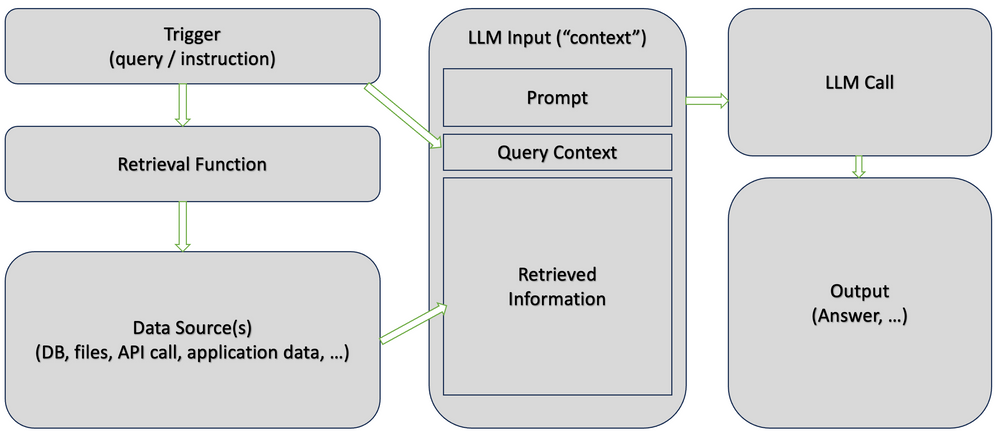TL;DR:
- Retrieval-augmented generation selectively retrieves info to inform the LLM’s outputs.
- Grounding LLMs allows creating customized AI tools aligned to your niche use case.
- With proper techniques, grounding fortifies data privacy while leveraging LLMs.
Artificial intelligence is transforming businesses, but many companies are hesitant to fully embrace its potential because of concerns around data privacy and security. LLMs (large language models), like the core of ChatGPT, boast impressive language skills, yet lack specific knowledge about your business. Fortunately, a technique called “Grounding” empowers you to create tailored AI tools that leverage LLMs’ abilities while keeping your data confidential.
Here’s what you need to know about Grounding and how it can help empower your company’s AI strategy.
What Is Grounding?
Grounding is the process of providing an LLM with relevant information and context for a specific task or domain. This additional knowledge enhances the quality and accuracy of the LLM’s outputs for that use case. Grounding bridges the gap between the LLM’s general knowledge and skills and the niche expertise required for business applications.
There are several Grounding techniques, but one of the most effective is called Retrieval-Augmented Generation (RAG). RAG retrieves information from a controlled knowledge source and feeds it to the LLM to inform its responses. This allows an LLM to generate high-quality content relying on business-specific data without exposing confidential info.
What’s The Difference Between Grounding And LLMs?
Here’s an example to help better explain the difference between Grounding and LLMs:
Think of your complete knowledge from math class in elementary school as a locked LLM inside your brain. What you learned in elementary math class can’t be updated. But today you learned a new trick in Microsoft Excel‘s Formula bar. To run the calculation in the Formula bar, you are using the basic math skills that you learned in elementary school (LLM), but you are Grounding the connection between those basic math skills with the new Formula trick to generate a new solution.
Grounding LLMs Can Help Unlock Targeted AI Capabilities
Grounding an LLM creates a custom AI solution tailored to your needs. The LLM gains a nuanced understanding of your company, products, workflows, and customers without you relinquishing control of private data back into the LLM.
For example, you could build an AI-powered support agent that interacts with customers conversationally, yet remains consistent with your brand identity, approved messaging, and public-facing information. Grounding the AI tools arms the agent with information to resolve issues accurately and securely.
In another scenario, Grounding enables an LLM to draft potent marketing copy or composed emails aligned with data-backed insights about campaigns and target demographics. The LLM produces relevant content faster without direct access to underlying customer data.
Maintain Data Privacy While Accessing Niche Knowledge
Proper Grounding techniques allow feeding select information to an LLM without exposing raw datasets or confidential records. RAG only retrieves approved snippets rather than full documents. With the right protocols, this retrieval process can be quarantined from wider systems access.
Grounding data sources like databases, files, API calls, or application data (bottom left box in diagram), consolidate need-to-know info in a structured, managed repository. This provides relevant context for the LLM (center box in diagram) separate from large data collections containing irrelevant or sensitive information.

LLMs have no way to bypass security controls when Grounded properly. Anchoring LLMs to curated Grounded inputs allows your AI tech stack to produce custom outputs for your staff without creating security headaches for your developers or IT departments.
Start Small and Iterate to Fit Your Needs
Begin Grounding by identifying a promising use case that would benefit from an LLM’s capabilities connected to your organization’s niche knowledge. Assemble a small Grounding dataset with carefully selected info to provide the necessary context without overexposing your data security.
Build RAG retrieval functionality to supply key info from the Grounding source in response to queries. Integrate this customized LLM into an application for your targeted scenario. Analyze its effectiveness and refine the Grounding approach.
Once a solid foundation has been established, the solution can be expanded into further applications across the business. With each iteration, improve Grounding techniques to enhance capabilities while upholding security standards.
Extend Your Competitive Edge With Customized AI Tools

AI presents game-changing potential for businesses, but it requires careful planning when handling sensitive data. Grounding methodologies like RAG allow companies to create LLMs powered by specialized, relevant knowledge – without relinquishing control of their sensitive information assets.
Unlocking targeted AI capabilities while prioritizing data protection provides a winning strategy for your AI strategy. With thoughtful design and following best practices, a Grounded LLM can give your organization an incredible edge against your competition.
Unlock the power of #AI for your business while maintaining data privacy by #Grounding your #LLM with retrieval-augmented generation. #NLProc #MachineLearning #RAG #LLMs Share on X










 19 Surprising Godfather Facts About The Classic Film
19 Surprising Godfather Facts About The Classic Film
Leave a Reply
You must be logged in to post a comment.